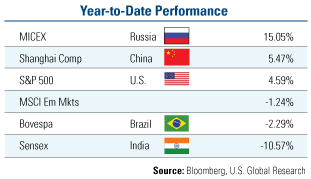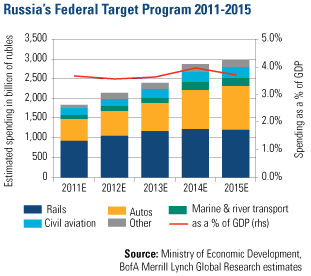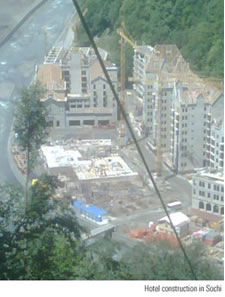What's Driving Russia's Stock Market Outperformance?
Stock-Markets / Russia Mar 29, 2011 - 02:09 AM GMTBy: Frank_Holmes
 The Russian MICEX Index, which increased 22.5 percent in 2010, has jumped 15 percent so far in 2011, significantly outperforming many other markets.
The Russian MICEX Index, which increased 22.5 percent in 2010, has jumped 15 percent so far in 2011, significantly outperforming many other markets.
China is the second-best performer of the BRICs, rising more than 5 percent, while India (down over 10 percent) and Brazil (down over 2 percent) have lagged. Overall, the MSCI Emerging Markets Index has dropped just over 1 percent.
 This has effectively recoupled Russia with the other BRIC countries. The Russian economy lagged out-of-the-gate once the global recovery began, leading some to question whether it belonged in the same category as Brazil, China and India. Those sentiments seemed premature and symptomatic of an anti-Russia mindset.
This has effectively recoupled Russia with the other BRIC countries. The Russian economy lagged out-of-the-gate once the global recovery began, leading some to question whether it belonged in the same category as Brazil, China and India. Those sentiments seemed premature and symptomatic of an anti-Russia mindset.
Russian's outperformance has been driven by several factors. First, the Russian ruble has appreciated 7 percent against the U.S. dollar, boosting stock market performance for U.S. investors. This development also has a long-term benefit as a strong ruble benefits the country's domestic sectors, something we'll discuss later.
A second factor driving Russia has been the geopolitical and natural disaster events that have transpired during the past few weeks. Russia is relatively safe from the type of political uprisings seen in the Middle East and North Africa. Its government is decidedly popular with the public and the one-two punch of President Medvedev and Prime Minister Putin give the government clout on both international and domestic fronts.
The price of oil has risen roughly 25 percent since the unrest and turmoil began in the Middle East and North Africa. As an energy exporter of crude oil and natural gas, Russia is one of the few large economies in the world that directly benefits from higher energy prices.
Russia is the world's largest oil producer and it's estimated that for every $10 increase in the average annual price of oil, Russia's revenues rise by $20 billion, according to the Financial Times. Since Russia is not a member of OPEC, it is not bound by production caps and can increase production as it sees fit while prices are at elevated levels.
Russia is also the world's top exporter of natural gas and Stratfor Intelligence points out the situation in Libya has shut down 11 billion cubic-meters of natural gas flow to Italy. As Europe's third-largest consumer of natural gas, Italy has turned to Russia for gas supplies. In addition, a shutdown of several Japanese nuclear facilities could mean as much as a 14 percent increase in natural gas consumption to meet the Japan's energy demands.
In the energy sector, the Eastern European Fund (EUROX) portfolio emphasizes companies that show strong growth in production, reserves and cash flow, relative to their peers. Specifically, Novatek, Rosneft and TNK-BP fit this profile.
Russian energy equities, which carry the largest weighting in the MICEX, have gained 25 percent this year. This is higher than non-oil Russian equities, which have risen only 7.7 percent. However, as oil and gas taxes swell the government's revenue, these funds are increasingly allocated to social and public works programs which are likely to create an opportunity for non-energy related equities. These sectors appear poised to benefit from the current macroeconomic environment.
This table from Merrill Lynch shows the performance of the different sectors of the Russian market following a sustained rise in oil prices. Merrill Lynch compiled research on the seven instances where oil prices rose 20 percent in a two-month span and maintained at least half those gains over the following six month period.

Historically, the average gain for Russian equities is more than 34 percent. While energy generally jumps out ahead when oil prices move higher, you can see that it lags other sectors as the rally progresses. We have long been positive on both Russian financials and the consumer sector and these sectors appear well positioned going forward.
Consumer-oriented equities such as retailers have historically been the best performers, netting an 85 percent gain on average and triple the gain of energy equities. Retailers X5 and Magnit should be able to capitalize on these trends. Russian financials are next with an average 83 percent gain. Sberbank, Russia's largest bank, is the largest holding in EUROX.
Another area that could directly benefit from the Kremlin's cash-filled pockets is infrastructure. Russia is in dire need of a significant revamping of its infrastructure. Similar to the American Society of Civil Engineers report that rates America's infrastructure a "D," the World Economic Forum says the quality of Russia's infrastructure lags that of other emerging countries such as South Africa, Turkey, China and Mexico.
The areas most in need of upgrading are Russia's transportation and electrical power grid. The quality of Russia's roads ranks in the bottom-third in the world, according to Merrill Lynch, and it's estimated that Russia loses 6 percent of GDP each year due to underdeveloped roads. In fact, the combined length of Russia's roadways declined 6 percent between 2002 and 2010 despite a 60 percent increase in car penetration, Merrill-Lynch says.
It's a similar story for Russia's airports and rail network. Russia currently has roughly 300 operational airports but just 40 percent of them have paved runways and 30 percent do not have an airfield lighting system, Merrill Lynch says. The rail network, almost entirely constructed during the Soviet era, is highly concentrated in the Western region of the country and is estimated to require more than $70 billion in investment for upgrades and repairs by 2020, according to Merrill Lynch.
Russia's aging power grid is unreliable and accident prone. Merrill Lynch projects that significant investment by 2020 is required to update and modernize the grid. With industrial consumers accounting for 85 percent of electrical consumption, keeping the power up and running is essential to maintaining Russia's industrial production levels.
To finance the much needed infrastructure improvements, the Russian government created the $420 billion Federal Target Program (FTP). The FTP focuses on key transportation areas such as rails, autos, marine and civil aviation.

The FTP has specific goals to meet by 2015 such as increasing the percentage of roads that meet federal standards by 23 percent. The plan also calls for a 47 percent increase in the shipment of goods and a 40 percent increase in airline penetration through improvements of aviation infrastructure.

In addition to the FTP, three special events will help drive Russia's infrastructure spending: The 2012 Asia-Pacific Economic Cooperation (APEC) Summit, 2014 Winter Olympics in Sochi and the 2018 World Cup. Merrill Lynch estimates that total spending for the World Cup will reach $50 billion. Construction for the Games in Sochi includes 161 miles of roads and 65 miles of rails, and the APEC calls for 48 new objects to be constructed for a total of $83 million.
While higher energy prices are in danger of slowing down consumers in the U.S., Western Europe and certain emerging market countries, it has the opposite effect for the Russian economy. With increased cash flow from its natural gas and crude oil exports, the Russian government has the much needed capital to invest in the country's aging infrastructure and to support domestic consumption.
This should drive outperformance of Russian markets throughout 2011 and stimulate demand for infrastructure-related commodities such as crude oil, copper, cement and iron ore.
For more updates on global investing from Frank and the rest of the U.S. Global Investors team, follow us on Twitter at www.twitter.com/USFunds or like us on Facebook at www.facebook.com/USFunds. You can also watch exclusive videos on what our research overseas has turned up on our YouTube channel at www.youtube.com/USFunds.
Please consider carefully the fund's investment objectives, risks, charges and expenses. For this and other important information, obtain a fund prospectus by visiting www.usfunds.com or by calling 1-800-US-FUNDS (1-800-873-8637). Read it carefully before investing. Distributed by U.S. Global Brokerage, Inc.
Standard deviation is a measure of the dispersion of a set of data from its mean. The more spread apart the data, the higher the deviation. Standard deviation is also known as historical volatility. All opinions expressed and data provided are subject to change without notice. Some of these opinions may not be appropriate to every investor. The S&P 500 Stock Index is a widely recognized capitalization-weighted index of 500 common stock prices in U.S. companies. The NYSE Arca Gold BUGS (Basket of Unhedged Gold Stocks) Index (HUI) is a modified equal dollar weighted index of companies involved in gold mining. The HUI Index was designed to provide significant exposure to near term movements in gold prices by including companies that do not hedge their gold production beyond 1.5 years. The MSCI Emerging Markets Index is a free float-adjusted market capitalization index that is designed to measure equity market performance in the global emerging markets. The U.S. Trade Weighted Dollar Index provides a general indication of the international value of the U.S. dollar.
Frank Holmes Archive |
© 2005-2022 http://www.MarketOracle.co.uk - The Market Oracle is a FREE Daily Financial Markets Analysis & Forecasting online publication.



